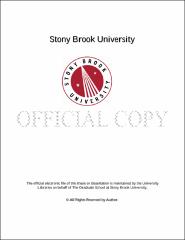| dc.identifier.uri | http://hdl.handle.net/11401/76730 | |
| dc.description.sponsorship | This work is sponsored by the Stony Brook University Graduate School in compliance with the requirements for completion of degree. | en_US |
| dc.format | Monograph | |
| dc.format.medium | Electronic Resource | en_US |
| dc.language.iso | en_US | |
| dc.publisher | The Graduate School, Stony Brook University: Stony Brook, NY. | |
| dc.type | Dissertation | |
| dcterms.abstract | One of the measurements obtained from heavy ion collisions is the correlation between two final particles as a function of the difference of azimuthal angle and pseudorapidity. These correlations show structure in the azimuthal direction that is elongated in pseudorapidity, and that has its origin in the initial state after the collision, and in its evolution. We implemented a Glauber Monte Carlo code to study initial state fluctuations that appear on an event by event basis because of the random positions of the nucleons in the nuclei. We calculated the initial average deformations and their fluctuations as a function of the centrality of the collision and found that for central collisions all of the asymmetry parameters are on equal footing, but that as the collisions become more peripheral the second asymmetry parameter becomes more important, because of the almond-like shape of the region where the two nuclei intersect. To study the evolution of the matter created after the collision we used the SO(3)-invariant flow developed by S. Gubser and A. Yarom, that is an extension of Bjorken flow that includes flow in the radial direction. The hydrodynamic equations including perturbations to this background can be solved analytically in terms of known special functions that can be collected to describe the shape of a specific perturbation. We used as initial condition a Gaussian perturbation, and found that the two particle correlation obtained resembles the curve from experiments. We also explored the effects of viscosity on the final particle correlation, and on the spectra of the flow coefficients, and found that viscosity kills the higher harmonics. The same method can be used to study other perturbations to the background. In particular, we studied fluctuations that appear near the critical temperature produced by Quark Gluon Plasma clusters undergoing a Rayleigh type collapse, and suggest that the observed widening in rapidity correlations may be an indication of sound propagating from such fluctuations. | |
| dcterms.available | 2017-09-20T16:51:04Z | |
| dcterms.contributor | Shuryak, Edward | en_US |
| dcterms.contributor | McGrew, Clark | en_US |
| dcterms.contributor | Drees, Axel | en_US |
| dcterms.contributor | Lacey, Roy | en_US |
| dcterms.contributor | McLerran, Larry. | en_US |
| dcterms.creator | Staig Fernandez, Maria del Pilar | |
| dcterms.dateAccepted | 2017-09-20T16:51:04Z | |
| dcterms.dateSubmitted | 2017-09-20T16:51:04Z | |
| dcterms.description | Department of Physics. | en_US |
| dcterms.extent | 105 pg. | en_US |
| dcterms.format | Monograph | |
| dcterms.format | Application/PDF | en_US |
| dcterms.identifier | http://hdl.handle.net/11401/76730 | |
| dcterms.issued | 2013-12-01 | |
| dcterms.language | en_US | |
| dcterms.provenance | Made available in DSpace on 2017-09-20T16:51:04Z (GMT). No. of bitstreams: 1
StaigFernandez_grad.sunysb_0771E_11490.pdf: 5640369 bytes, checksum: 67f5be2a9477f3cf308a349c1d85e5ad (MD5)
Previous issue date: 1 | en |
| dcterms.publisher | The Graduate School, Stony Brook University: Stony Brook, NY. | |
| dcterms.subject | fluctuations, heavy ion collisions, hydrodynamics, quark gluon plasma | |
| dcterms.subject | Physics | |
| dcterms.title | A Look at Heavy Ion Collisions Through the SO(3)-Invariant Flow | |
| dcterms.type | Dissertation | |

